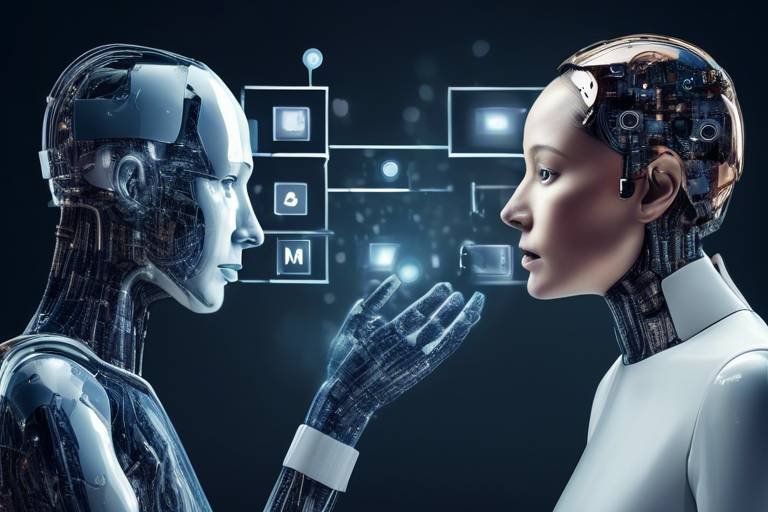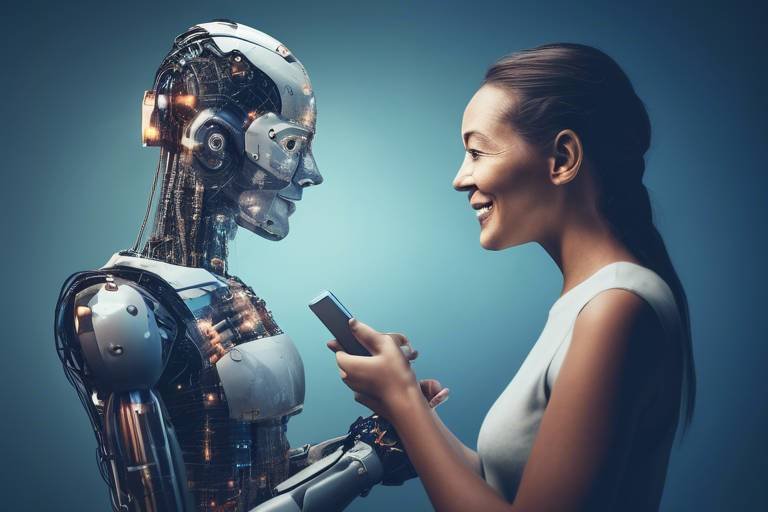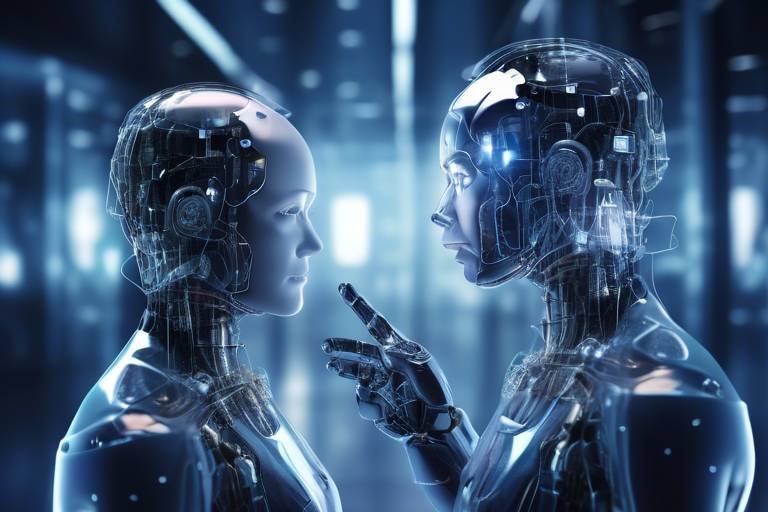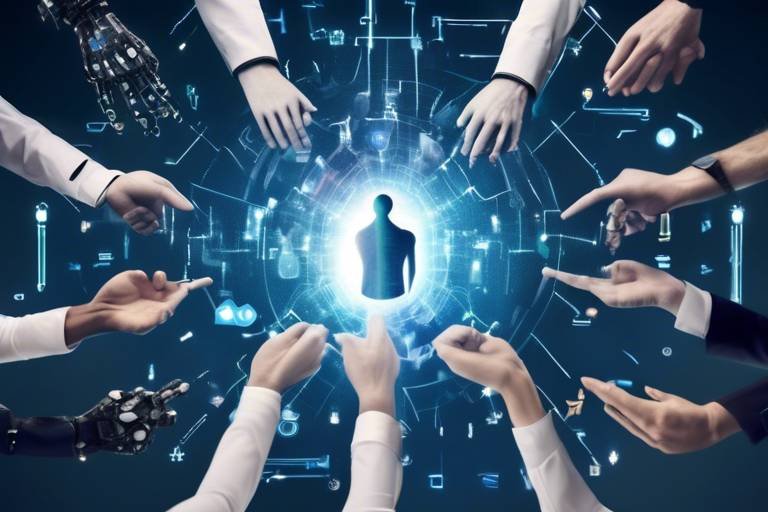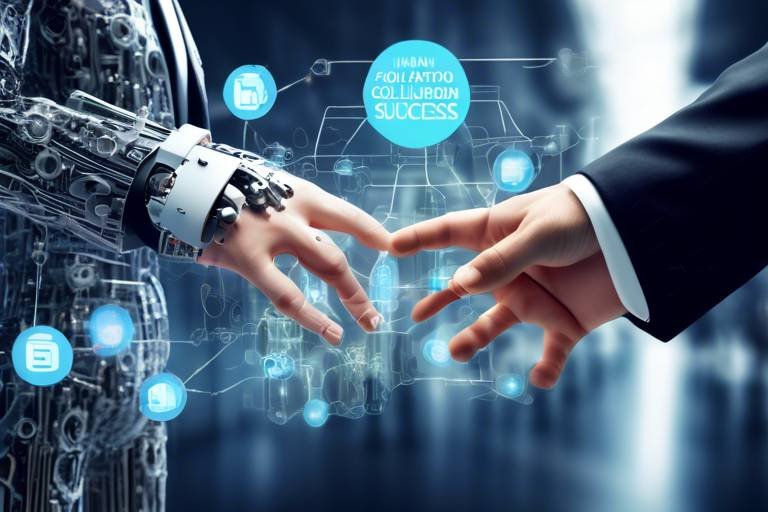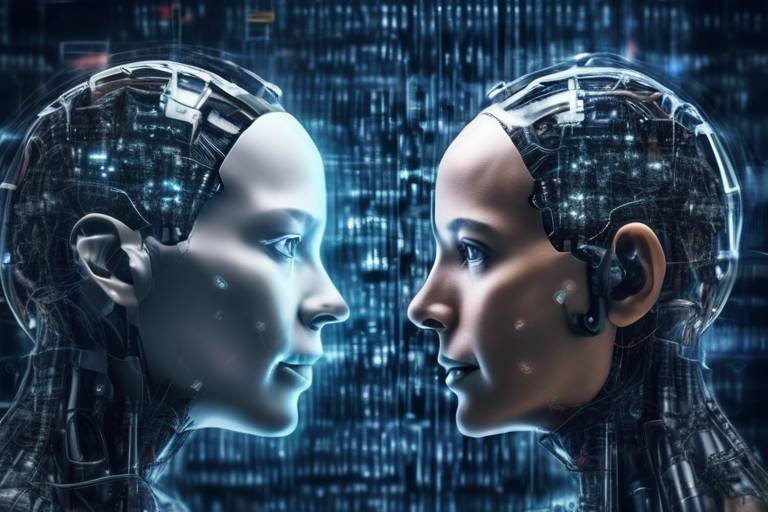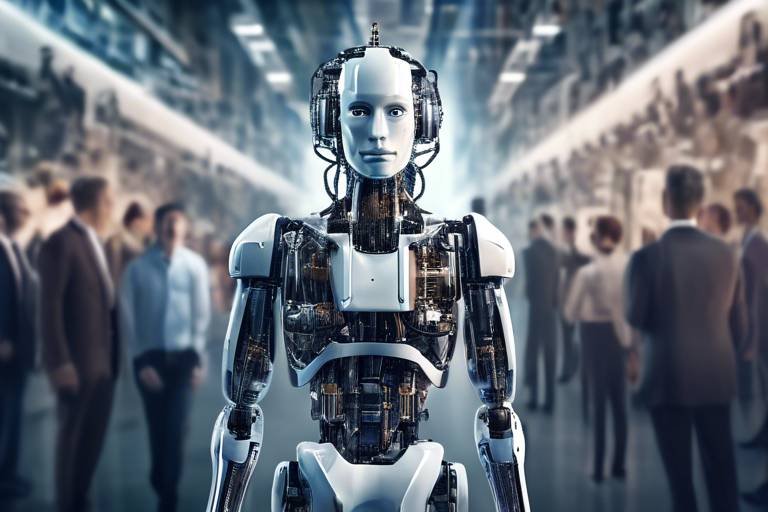How AI Technology Can Breed Unity Among Teams
In today's fast-paced work environment, the ability to collaborate effectively is more critical than ever. Enter AI technology, a game-changer that is revolutionizing the way teams interact and work together. Imagine a workplace where communication flows seamlessly, tasks are automated, and insights are readily available at your fingertips. Sounds like a dream, right? Well, it's becoming a reality thanks to AI. This article dives into the transformative role of AI in fostering collaboration and unity within teams, exploring its benefits, challenges, and practical applications in the workplace.
AI enhances team collaboration by streamlining communication, automating tasks, and providing insights that help members work together more effectively. Think of AI as the oil that keeps the machinery of teamwork running smoothly. With tools that can analyze data, predict project outcomes, and suggest optimal workflows, AI is here to make our lives easier. One of the most exciting aspects of AI is its ability to analyze team dynamics and suggest ways to improve them. For instance, AI can identify bottlenecks in communication or highlight team members who may need additional support, ultimately leading to a more cohesive and productive team environment.
When it comes to communication, clarity is key. AI-driven communication tools can significantly reduce misunderstandings and enhance clarity among team members. Imagine a team where everyone is on the same page, where messages are clear, and where the risk of miscommunication is minimized. Various platforms, such as chatbots and virtual assistants, utilize AI to improve communication. These tools can manage schedules, send reminders, and even summarize discussions, ensuring that no important detail slips through the cracks. Below are some benefits of AI-driven communication tools:
- Enhanced Clarity: AI tools help clarify messages, reducing the chances of misinterpretation.
- Increased Efficiency: Automating routine tasks allows team members to focus on more strategic work.
- 24/7 Availability: AI communication tools can operate round the clock, ensuring support is always available.
In today's globalized world, teams often consist of members from diverse linguistic backgrounds. This is where real-time language translation tools powered by AI come into play. These tools can bridge communication gaps, allowing team members to communicate effortlessly, regardless of their native language. Imagine a team meeting where everyone can express their ideas in their preferred language, and AI translates it in real-time for others. This not only enhances understanding but also fosters a sense of inclusivity among team members.
To illustrate the power of AI in fostering teamwork and inclusivity, let's look at a few real-world examples:
| Company | AI Tool Used | Outcome |
|---|---|---|
| Global Corp | AI Translation Software | Improved project collaboration among international teams. |
| Tech Innovations | AI Chatbot | Streamlined communication, reducing email overload. |
Despite their numerous benefits, AI translation tools are not without challenges. One significant issue is the potential for context misunderstanding, which can lead to miscommunication. For teams relying heavily on these tools, it's crucial to recognize these pitfalls and develop strategies to mitigate them. Regular training on the use of these tools and encouraging open dialogue can help teams navigate these challenges more effectively.
Task management can be a daunting challenge for any team. However, AI can significantly improve this aspect by automating scheduling and prioritization. Imagine having an assistant that not only organizes your tasks but also suggests the most efficient order to tackle them. AI tools can analyze deadlines, workloads, and team member availability to create a streamlined plan that keeps everyone focused on their goals. This allows teams to work smarter, not harder, and enhances overall productivity.
As we embrace AI in our workflows, transparency becomes crucial for building trust among team members. Clear communication regarding how AI systems work and their impact on team dynamics is essential. When team members understand the role of AI in their daily tasks, they are more likely to embrace it and collaborate effectively. This transparency fosters a culture of trust, where everyone feels valued and empowered to contribute.
As AI becomes more integrated into team workflows, ethical considerations arise. It's essential to establish guidelines that ensure AI is used responsibly and fairly within teams. This includes addressing issues such as data privacy, bias in AI algorithms, and the implications of automation on job roles. By prioritizing ethical AI usage, teams can foster a healthy work environment where everyone feels respected and included.
Looking ahead, the potential advancements in AI technology are staggering. As AI continues to evolve, we can expect even more innovative solutions that enhance team unity and collaboration. From more sophisticated communication tools to advanced project management systems, the future of work is bright with AI. Imagine a workplace where AI not only supports but actively enhances the human element of teamwork, creating a truly collaborative environment.
Q: How can AI improve team communication?
A: AI can streamline communication by providing real-time translations, summarizing discussions, and automating routine tasks, ensuring everyone is informed and on the same page.
Q: What are the ethical considerations of using AI in teams?
A: Ethical considerations include data privacy, algorithmic bias, and ensuring that AI is used responsibly to enhance rather than replace human roles.
Q: Can AI help with task management?
A: Absolutely! AI can automate scheduling, prioritize tasks based on deadlines and workloads, and keep teams organized and focused on their goals.

The Role of AI in Team Collaboration
In today's fast-paced work environment, team collaboration is more important than ever. With teams often spread across different locations and time zones, the need for efficient communication and coordination has become paramount. This is where AI technology steps in as a game-changer. By automating routine tasks, streamlining communication, and providing insightful analytics, AI enhances the way teams collaborate and achieve their goals.
Imagine a world where your team can communicate seamlessly, regardless of their location. AI tools like chatbots and virtual assistants can facilitate real-time communication, allowing team members to share ideas and feedback instantly. These tools not only help in reducing response times but also ensure that everyone is on the same page. For instance, AI-driven platforms can analyze ongoing conversations, summarize key points, and highlight action items, making it easier for teams to keep track of their projects.
Moreover, AI can automate mundane tasks that often consume valuable time. Think about how much time is spent on scheduling meetings or sending reminders. With AI, these tasks can be managed automatically, freeing up team members to focus on what truly matters—creative problem-solving and innovation. By taking over the repetitive tasks, AI allows teams to concentrate on collaboration, enhancing their productivity and overall effectiveness.
One of the most significant advantages of AI in team collaboration is its ability to provide data-driven insights. AI tools can analyze team performance metrics, identify bottlenecks, and suggest improvements. For example, if a project is lagging behind schedule, AI can pinpoint the reasons and recommend strategies to get back on track. This level of analysis not only helps in making informed decisions but also fosters a culture of continuous improvement within the team.
Furthermore, AI can enhance the inclusivity of teams by providing tools that cater to diverse needs. For example, AI-powered platforms can adapt to different work styles and preferences, ensuring that every team member can contribute effectively. This adaptability is crucial in fostering a sense of belonging and unity among team members, making everyone feel valued and heard.
In conclusion, AI technology is reshaping the landscape of team collaboration. By enhancing communication, automating tasks, and providing insightful analytics, AI not only boosts productivity but also fosters a collaborative spirit among team members. As we continue to embrace these technologies, the potential for creating unified and high-performing teams becomes limitless.

Benefits of AI-Driven Communication Tools
In today's fast-paced work environment, effective communication is the cornerstone of successful teamwork. Enter AI-driven communication tools, which are revolutionizing the way teams interact. These technologies not only streamline communication but also enhance clarity, ensuring that every team member is on the same page. Imagine a world where misunderstandings are minimized, and collaboration flourishes—this is the promise of AI communication tools.
One of the standout benefits of these tools is their ability to reduce misunderstandings. In a typical workplace, miscommunication can lead to errors, delays, and frustration. AI tools analyze conversations and provide real-time feedback, helping to clarify intentions and messages. For instance, platforms like Slack and Microsoft Teams are integrating AI features that suggest responses or highlight key points in conversations, making it easier for team members to grasp the essence of discussions without sifting through endless messages.
Moreover, AI-driven communication tools often come equipped with features that enhance team collaboration. For example, many applications now offer integrated project management capabilities that allow teams to discuss tasks, assign responsibilities, and track progress all in one place. This seamless integration creates a more cohesive working environment, where everyone can contribute their ideas and efforts towards common goals without the hassle of switching between multiple platforms.
Another critical advantage is the ability to support diverse teams. In our increasingly globalized world, teams often consist of members from various linguistic backgrounds. AI tools equipped with real-time language translation capabilities can bridge these gaps, allowing for smoother interactions. For instance, tools like Google Translate and Microsoft Translator can facilitate conversations in different languages, ensuring that language barriers do not hinder collaboration.
To illustrate the impact of AI-driven communication tools, let's take a look at a few key features:
| Feature | Description | Benefit |
|---|---|---|
| Real-time Feedback | AI analyzes conversations and provides instant suggestions. | Reduces misunderstandings and enhances clarity. |
| Integrated Project Management | Combines communication with task management. | Streamlines workflow and improves collaboration. |
| Language Translation | Translates conversations in real-time. | Facilitates communication across diverse teams. |
Ultimately, the benefits of AI-driven communication tools are clear: they foster a more inclusive, efficient, and collaborative work environment. By leveraging these technologies, teams can not only improve their communication but also enhance their overall productivity. As we embrace this new era of communication, the question remains: how can we further harness AI to promote unity and collaboration within our teams?

Real-Time Language Translation
In today’s globalized world, teams are more diverse than ever. Members might hail from different countries, speaking various languages, which can create a significant barrier to effective communication. Enter tools powered by artificial intelligence. These innovative solutions are game changers, acting as a bridge that connects team members from different linguistic backgrounds. Imagine a virtual meeting where a team from Spain, Japan, and Brazil collaborates seamlessly, understanding each other as if they spoke the same language. This is the magic of AI-driven translation tools!
These tools not only break down language barriers but also enhance understanding among team members. They can translate spoken words in real-time, allowing for fluid conversations during virtual meetings. This capability is particularly beneficial for organizations that operate across multiple regions. With AI translation, the nuances of language are captured, ensuring that the intended message is conveyed accurately. However, it’s not just about translating words; it’s about translating meaning. AI tools analyze context, tone, and even cultural references, making communication feel more natural and less mechanical.
For instance, consider a project team working on a multinational campaign. If a team member from Germany shares an idea in German, an AI translation tool can instantly convert their words into English, Spanish, or any other language the team uses. This capability fosters a sense of inclusivity and encourages participation from all members, regardless of their native language. The result? A more cohesive team that feels valued and understood.
However, it's essential to recognize that while these tools are incredibly beneficial, they are not without their challenges. Misinterpretations can occur, especially with idiomatic expressions or specialized jargon. To mitigate these risks, teams should combine AI translation tools with human oversight. This means having bilingual team members review translations for accuracy and context. In this way, the team can leverage the speed of AI while ensuring that the subtleties of human language are respected.
In conclusion, real-time language translation tools are revolutionizing the way teams communicate. They not only foster unity but also drive productivity by ensuring that everyone is on the same page. By embracing these technologies, organizations can create a more inclusive environment where every voice is heard, regardless of language barriers. The future of teamwork is undoubtedly bright, thanks to the advancements in AI!

Case Studies of Successful Implementations
When it comes to integrating AI translation tools into the workplace, several companies have set remarkable examples of how technology can enhance teamwork and inclusivity. One standout case is that of Airbnb, which has leveraged AI-driven translation services to connect hosts and guests from diverse linguistic backgrounds. By employing AI tools that automatically translate messages in real-time, Airbnb has not only improved communication but also fostered a sense of community among its users. This seamless interaction has led to higher satisfaction rates and an increase in successful bookings.
Another impressive example is IBM, which implemented AI translation tools within its global teams. With employees spread across different countries, IBM faced challenges in ensuring everyone was on the same page. By adopting AI-powered translation solutions, they managed to break down language barriers, allowing team members to collaborate on projects without the hindrance of misunderstandings. As a result, IBM reported a significant increase in project efficiency and a noticeable improvement in team morale.
In the tech startup sector, Duolingo has utilized AI translation tools to enhance its language learning platform. By enabling users to communicate in their native languages while learning new ones, Duolingo has created an engaging and interactive environment for its users. This not only boosts the learning experience but also encourages users to collaborate and share knowledge, thus building a vibrant community around language learning.
While these case studies highlight the positive impacts of AI translation tools, it’s essential to recognize the importance of continuous improvement and adaptation. Companies like Spotify have also embraced AI to manage their diverse workforce. By implementing AI-driven communication tools, Spotify has ensured that all team members, regardless of their location or language, can contribute effectively to projects. The results have been overwhelmingly positive, with enhanced creativity and innovation stemming from more inclusive collaboration.
It's clear that successful implementations of AI tools can lead to remarkable outcomes. However, it’s crucial for organizations to approach these technologies with a strategy that includes training, feedback, and regular updates to the AI systems. This ensures that the tools remain effective and continue to meet the evolving needs of the teams.
- What are AI translation tools? AI translation tools are software applications that utilize artificial intelligence to convert text or speech from one language to another in real-time, facilitating communication among individuals who speak different languages.
- How can AI improve team collaboration? AI can streamline communication, automate repetitive tasks, and provide insights that help teams work together more effectively, ultimately enhancing productivity.
- Are there any challenges associated with using AI translation tools? Yes, challenges can include context misunderstanding and nuances in language that AI may not fully grasp, but these can often be mitigated through proper training and user feedback.
- What ethical considerations should teams keep in mind when using AI? Teams should ensure that AI is used responsibly, with transparency about how it functions and its impact on team dynamics, to build trust and maintain ethical standards.

Challenges with AI Translation Tools
While AI translation tools have made remarkable strides in bridging communication gaps, they are not without their challenges. One of the most significant issues is the context misunderstanding. AI systems often struggle to grasp the nuances of human language, which can lead to translations that miss the mark. For instance, idiomatic expressions or cultural references can easily be lost in translation, leaving team members confused or misinterpreting the intended message.
Another challenge is the accuracy of translations. Although AI tools are constantly learning and improving, they may still falter when it comes to specialized terminology or jargon specific to certain industries. This can be particularly problematic in fields like medicine or law, where precise language is crucial. Teams relying on these tools must remain vigilant and double-check translations to ensure clarity and accuracy.
Additionally, there is a dependency risk associated with using AI translation tools. Teams may become overly reliant on these technologies, which can diminish their own language skills and cultural awareness. This reliance can create a scenario where team members feel less inclined to learn a new language or understand the cultural nuances of their colleagues, ultimately undermining the very unity these tools are meant to foster.
Furthermore, data privacy concerns arise when using AI translation tools. Many of these platforms require access to sensitive information to provide accurate translations. This raises questions about how data is stored and used, and whether it could be exposed to unauthorized parties. Teams must weigh the benefits of using these tools against the potential risks to their confidential information.
To navigate these challenges effectively, teams can adopt a few strategies. First, they should combine AI translation tools with human oversight. By having bilingual team members review translations, organizations can ensure that the nuances and context are preserved. Second, investing in training sessions to enhance cultural awareness and language skills can empower team members and reduce dependency on AI tools. Lastly, maintaining transparency about how AI tools operate and the data they use can help alleviate privacy concerns, fostering trust among team members.

AI and Task Management
In today's fast-paced work environment, managing tasks efficiently can feel like trying to juggle flaming torches while riding a unicycle. It's no wonder that teams often struggle to stay organized and focused on their goals. Enter AI technology, the game-changer that can help teams not only manage their tasks but also elevate their productivity to new heights. By automating scheduling, prioritization, and even reminders, AI tools can transform the way teams operate.
Imagine having a virtual assistant that understands your team's workload, deadlines, and individual strengths. AI task management tools can analyze this data and suggest optimal ways to allocate tasks, ensuring that everyone is working on what they do best. This not only streamlines processes but also enhances overall team morale, as members feel empowered to contribute in ways that align with their skills.
One of the standout features of AI in task management is its ability to automate repetitive tasks. Think about all the time spent on sending reminders, updating spreadsheets, or scheduling meetings. With AI, these mundane tasks can be handled seamlessly, allowing team members to focus on more strategic initiatives. For instance, AI-driven platforms can automatically schedule meetings based on team availability, eliminating the back-and-forth emails that often lead to frustration.
Moreover, AI tools can provide real-time insights into project progress. Imagine a dashboard that not only tracks deadlines but also highlights potential bottlenecks before they become a problem. This proactive approach enables teams to address issues swiftly, ensuring that projects stay on track. By utilizing data analytics, AI can identify patterns in team performance, helping leaders make informed decisions about resource allocation and project timelines.
However, it's essential to remember that while AI can significantly enhance task management, it should not replace human intuition and creativity. The best outcomes arise when AI complements human efforts, allowing teams to leverage technology while still fostering collaboration and innovation. As teams embrace AI tools, they must also cultivate a culture that values open communication and feedback, ensuring that technology serves as a bridge rather than a barrier.
In summary, AI technology has the potential to revolutionize task management within teams. By automating routine tasks, providing real-time insights, and enhancing collaboration, AI empowers teams to work smarter, not harder. As we move forward, it's crucial for teams to embrace these tools while maintaining a human touch, ensuring that technology enhances their unique dynamics rather than overshadowing them.
- What are some popular AI task management tools? Some popular AI task management tools include Asana, Trello, and Monday.com, which incorporate AI features to streamline workflows and enhance collaboration.
- How can AI improve team communication? AI can improve team communication by providing real-time updates, automating reminders, and even offering language translation to bridge communication gaps.
- Are there any downsides to using AI in task management? Yes, potential downsides include over-reliance on technology, data privacy concerns, and the need for ongoing training to ensure effective use of AI tools.
- Can AI help with remote team management? Absolutely! AI can facilitate remote team management by automating scheduling, tracking progress, and enhancing communication across different time zones.

Building Trust Through AI Transparency
In today's fast-paced work environment, the integration of AI technology into team dynamics is not just a trend; it's a necessity. However, for teams to fully embrace AI, there must be a foundation of trust built through transparency. When team members understand how AI tools function and the rationale behind their implementation, they are more likely to engage with them positively. Imagine a ship sailing smoothly across the ocean; that’s what a transparent AI system can do for a team—navigate through challenges with clarity and confidence.
Transparency in AI means that all team members are informed about how decisions are made, what data is being used, and how AI tools are impacting their workflows. This understanding can significantly reduce anxiety and skepticism surrounding AI. For instance, if team members know how an AI tool prioritizes tasks, they can better align their efforts and trust the system's recommendations. Without this transparency, AI can feel like a black box—mysterious and potentially intimidating.
Moreover, clear communication about AI processes can foster a culture of collaboration. When team members are encouraged to ask questions and share concerns about AI systems, it opens up avenues for discussion and feedback. This dialogue not only enhances understanding but also allows for collective problem-solving. Think of it as a potluck dinner where everyone brings their favorite dish to the table; the more diverse the contributions, the richer the experience for everyone involved.
However, achieving transparency is not without its challenges. Companies must be proactive in educating their teams about AI technologies. This could involve training sessions, workshops, or even simple informational emails that break down complex concepts into digestible parts. For example, a company could create a transparency dashboard that displays how AI algorithms are making decisions based on real-time data. By doing so, they demystify the AI process and allow team members to see the value it adds to their daily tasks.
To further illustrate the importance of transparency, consider the following key aspects:
- Open Communication: Regular updates about AI implementations and their impacts on team dynamics.
- Feedback Mechanisms: Establishing channels for team members to voice concerns or suggestions regarding AI tools.
- Educational Resources: Providing easy access to materials that explain AI functionalities and benefits.
In conclusion, building trust through AI transparency is essential for fostering a collaborative team environment. By ensuring that team members are informed and engaged with the AI tools they use, organizations can create a culture of openness. This not only enhances productivity but also cultivates a sense of belonging and unity within the team. As we move forward into an increasingly AI-driven future, let’s remember that transparency is not just a feature; it’s a critical component of successful teamwork.
- What is AI transparency? AI transparency refers to the clarity and openness about how AI systems operate, including the data used and decision-making processes.
- Why is transparency important in AI? Transparency builds trust among team members, reduces skepticism, and encourages collaboration, leading to more effective utilization of AI tools.
- How can companies promote AI transparency? Companies can promote transparency by providing training, creating feedback channels, and offering educational resources about AI technologies.

Ethical Considerations in AI Usage
As we dive deeper into the world of AI technology, it's essential to pause and reflect on the ethical considerations that accompany its usage. While AI can be a powerful ally in enhancing team dynamics and collaboration, it also raises questions about responsibility, fairness, and transparency. After all, we are not just integrating machines into our workflows; we are inviting them into our workplaces, shaping our interactions, and influencing our decisions.
One of the primary concerns is bias in AI algorithms. If the data fed into AI systems is biased, the outcomes will be biased too. This can lead to unfair treatment of team members based on race, gender, or other characteristics. For example, if an AI tool is used for performance evaluations and it's trained on historical data that reflects past biases, it may perpetuate those biases, affecting promotions and opportunities. Therefore, it is crucial for organizations to regularly audit their AI systems and ensure that they are designed to promote fairness and equity.
Another significant concern is the transparency of AI processes. Team members need to understand how AI systems make decisions that affect their work. If an AI tool recommends a specific course of action, team members should be able to question and understand the reasoning behind that recommendation. This transparency fosters trust and encourages open dialogue, which are essential for a collaborative environment. Companies must prioritize clear communication about how AI works and the data it uses.
Moreover, the privacy of team members is a critical aspect that cannot be overlooked. AI systems often require access to sensitive information to function effectively. Organizations must implement robust data protection measures to safeguard personal information. This includes informing team members about what data is collected, how it is used, and ensuring that consent is obtained where necessary. Being transparent about data usage not only protects individuals but also builds a culture of trust within the team.
Finally, organizations should establish ethical guidelines for AI usage. These guidelines should outline the principles that govern the use of AI tools in the workplace, ensuring that they align with the company’s values. By setting clear boundaries and expectations, teams can navigate the complexities of AI integration with a sense of responsibility and integrity. It's not just about what AI can do, but also about what it should do.
In conclusion, while AI technology holds immense potential for enhancing team collaboration, it is imperative to approach its integration with a strong ethical framework. By addressing issues of bias, transparency, privacy, and responsibility, organizations can harness the power of AI to foster a more inclusive and united team environment.
- What are the main ethical concerns regarding AI? The primary concerns include bias in algorithms, transparency of processes, privacy of personal data, and the establishment of ethical guidelines.
- How can organizations ensure fairness in AI? Regular audits of AI systems, diverse data sets, and ongoing training can help mitigate bias and promote fairness.
- Why is transparency important in AI usage? Transparency builds trust among team members and encourages open communication, which is vital for collaboration.
- What role do ethical guidelines play in AI integration? Ethical guidelines help set clear expectations and boundaries for AI usage, ensuring alignment with company values.

The Future of AI in Team Dynamics
As we look toward the horizon, the role of AI technology in team dynamics is poised for an exciting evolution. Imagine a workplace where teams operate seamlessly, powered by AI that not only enhances productivity but also nurtures a sense of unity among members. This future isn't just a distant dream; it's rapidly becoming a reality. With advancements in machine learning and natural language processing, AI is set to revolutionize how teams collaborate, communicate, and connect.
One of the most thrilling prospects is the potential for AI to create personalized work experiences tailored to individual team members. Picture an AI assistant that understands each person's strengths, weaknesses, and preferences, offering customized suggestions for tasks, collaboration opportunities, and even social interactions. This level of personalization can lead to a more engaged and motivated workforce, where everyone feels valued and understood.
Moreover, the integration of AI-driven analytics can provide teams with real-time insights into their performance and collaboration patterns. By analyzing data on how projects are progressing and how team members interact, AI can identify areas for improvement and recommend strategies to enhance collaboration. This feedback loop can foster a culture of continuous improvement, where teams are encouraged to adapt and evolve together.
However, with great power comes great responsibility. As we embrace these advancements, it's crucial to address the ethical implications of AI in the workplace. Ensuring that AI systems are transparent and fair will be vital in maintaining trust among team members. Companies must prioritize ethical guidelines and practices to navigate the complexities of AI usage responsibly.
Looking ahead, we can anticipate a future where AI not only facilitates collaboration but also enhances emotional intelligence within teams. Imagine AI tools that can analyze team sentiment and morale, providing leaders with insights to foster a positive work environment. This could lead to more empathetic leadership and a greater sense of community among team members.
In conclusion, the future of AI in team dynamics is bright and full of potential. As technology continues to evolve, so too will the ways in which teams collaborate and connect. By embracing these changes and addressing the challenges that come with them, organizations can create a workplace that is not only productive but also inclusive and harmonious.
- How will AI change team collaboration in the future? AI is expected to enhance collaboration by providing personalized experiences, real-time analytics, and emotional intelligence insights.
- What are the ethical considerations of using AI in teams? It's essential to ensure transparency and fairness in AI systems to maintain trust and prevent bias.
- Can AI help improve team morale? Yes, AI tools can analyze team sentiment and provide insights to foster a positive work environment.
- What role will AI play in task management? AI will automate scheduling and prioritization, helping teams stay organized and focused on their goals.
Frequently Asked Questions
- How does AI enhance team collaboration?
AI enhances team collaboration by streamlining communication, automating repetitive tasks, and providing valuable insights that help team members work together more effectively. By integrating AI tools, teams can focus on their core responsibilities without getting bogged down by administrative work.
- What are the benefits of using AI-driven communication tools?
AI-driven communication tools can significantly reduce misunderstandings and enhance clarity among team members. These tools help ensure that everyone is on the same page, making it easier to share ideas and updates. This leads to improved productivity and a more cohesive team environment.
- Can AI translation tools really bridge communication gaps?
Absolutely! AI translation tools can facilitate real-time language translation, allowing team members from diverse linguistic backgrounds to communicate seamlessly. This capability fosters understanding and collaboration, ultimately leading to better project outcomes.
- What challenges do AI translation tools face?
While AI translation tools are beneficial, they can sometimes struggle with context and nuance, leading to misunderstandings. Teams can mitigate these issues by providing context and feedback to improve the accuracy of translations, ensuring smoother communication.
- How does AI improve task management?
AI improves task management by automating scheduling, prioritizing tasks, and providing reminders. This helps teams stay organized and focused on their goals, reducing the likelihood of missed deadlines and improving overall efficiency.
- Why is transparency important in AI processes?
Transparency in AI processes is crucial for building trust among team members. When everyone understands how AI systems work and their impact on team dynamics, it fosters a sense of security and collaboration, encouraging team members to embrace AI tools.
- What ethical considerations should teams keep in mind when using AI?
As AI becomes more integrated into team workflows, it's essential to consider ethical guidelines to ensure that AI is used responsibly and fairly. Teams should focus on issues like data privacy, bias in AI algorithms, and the potential impact on job roles.
- What does the future hold for AI in team dynamics?
The future of AI in team dynamics looks promising, with advancements expected to further enhance collaboration and unity. As AI technology continues to evolve, it will likely play an even more integral role in shaping the way teams work together, making collaboration more intuitive and effective.







